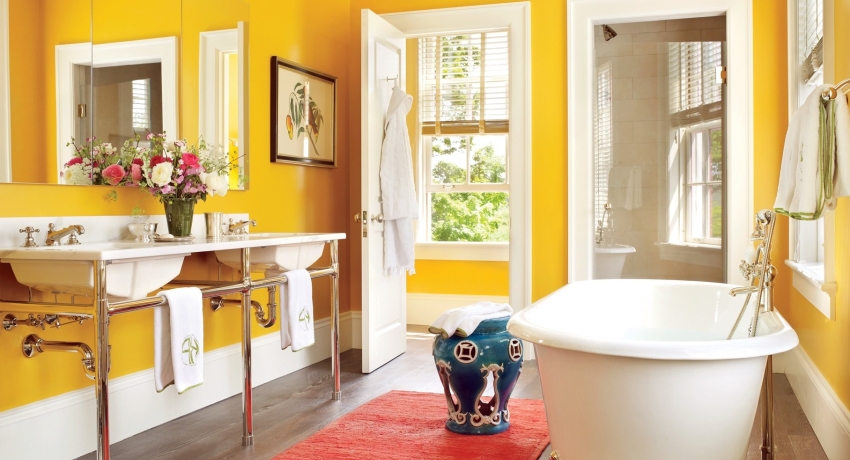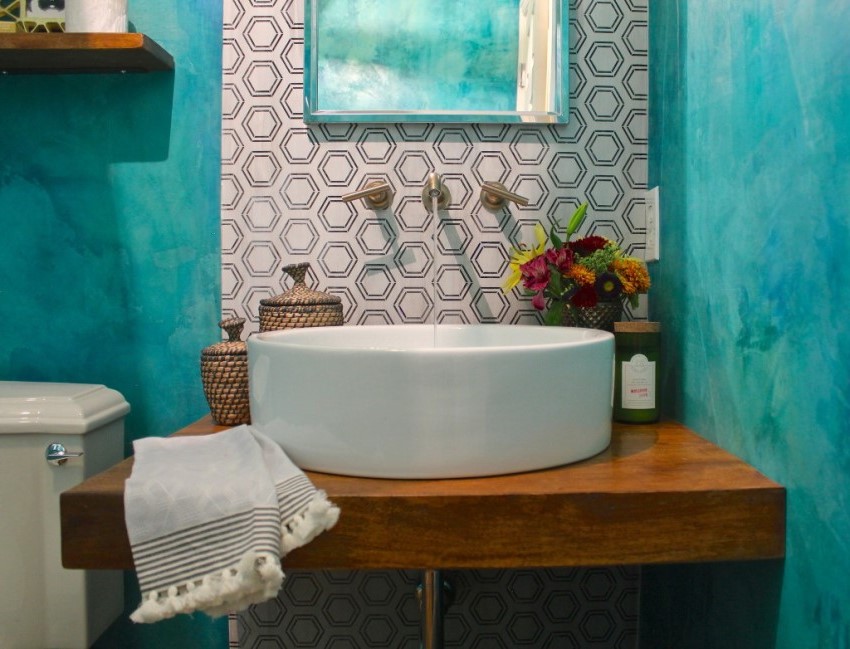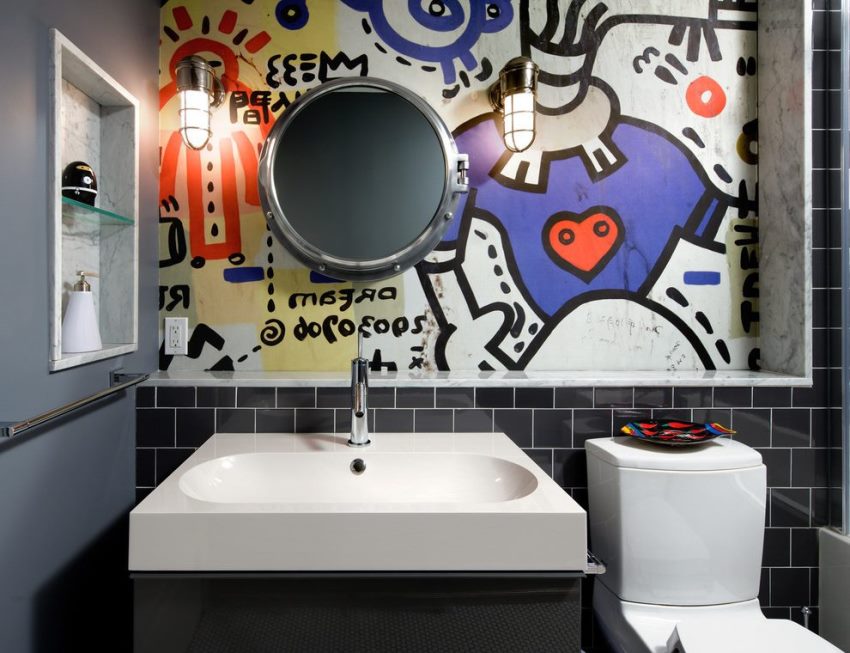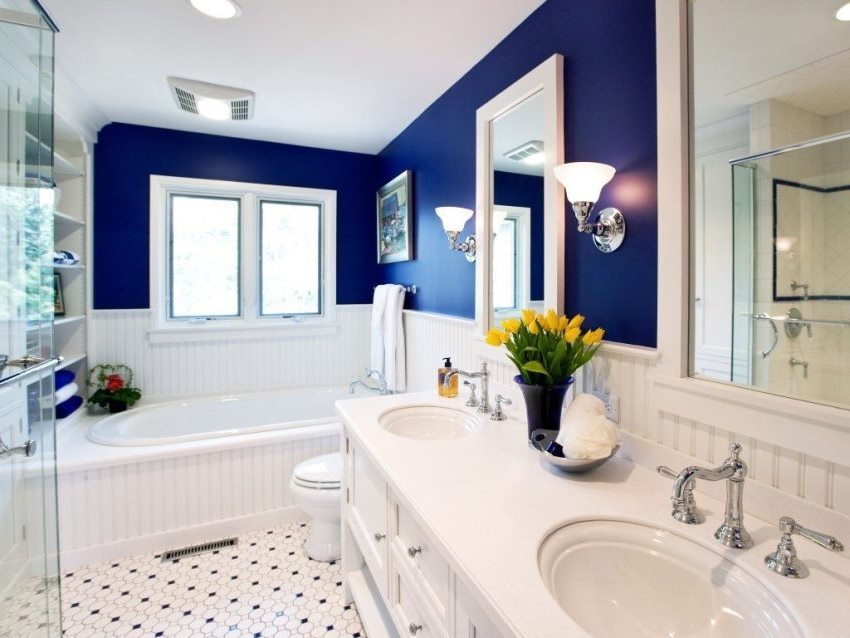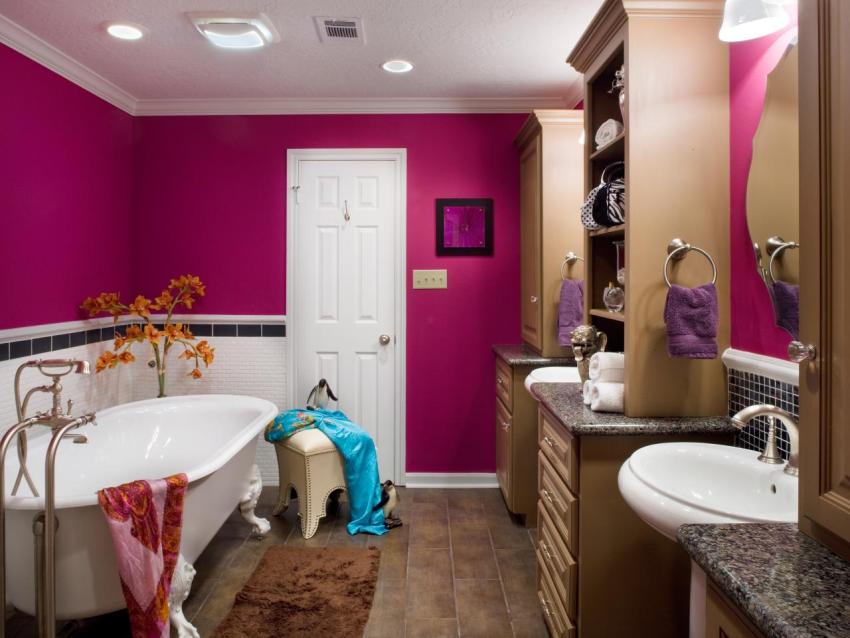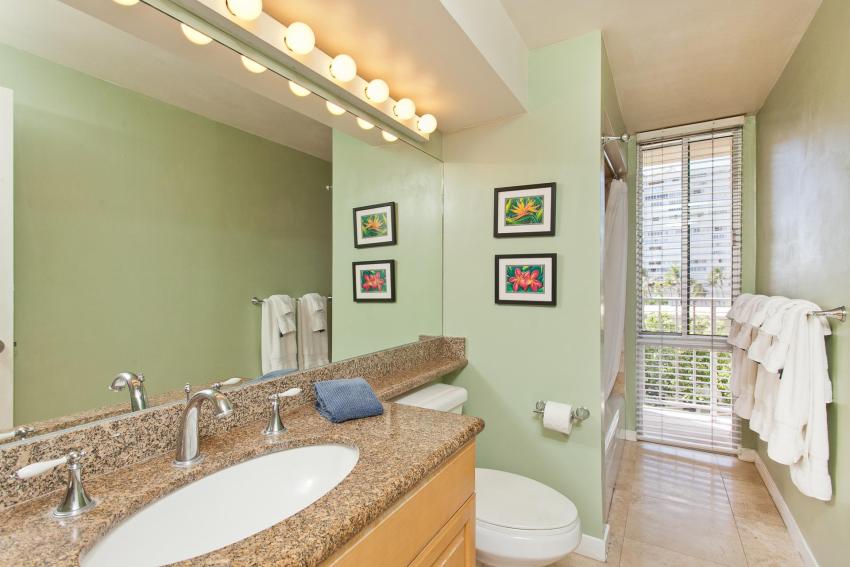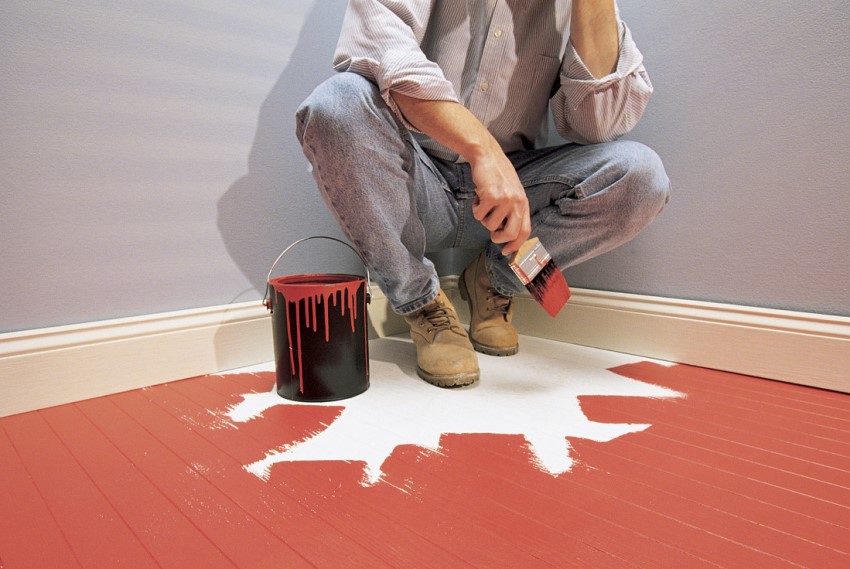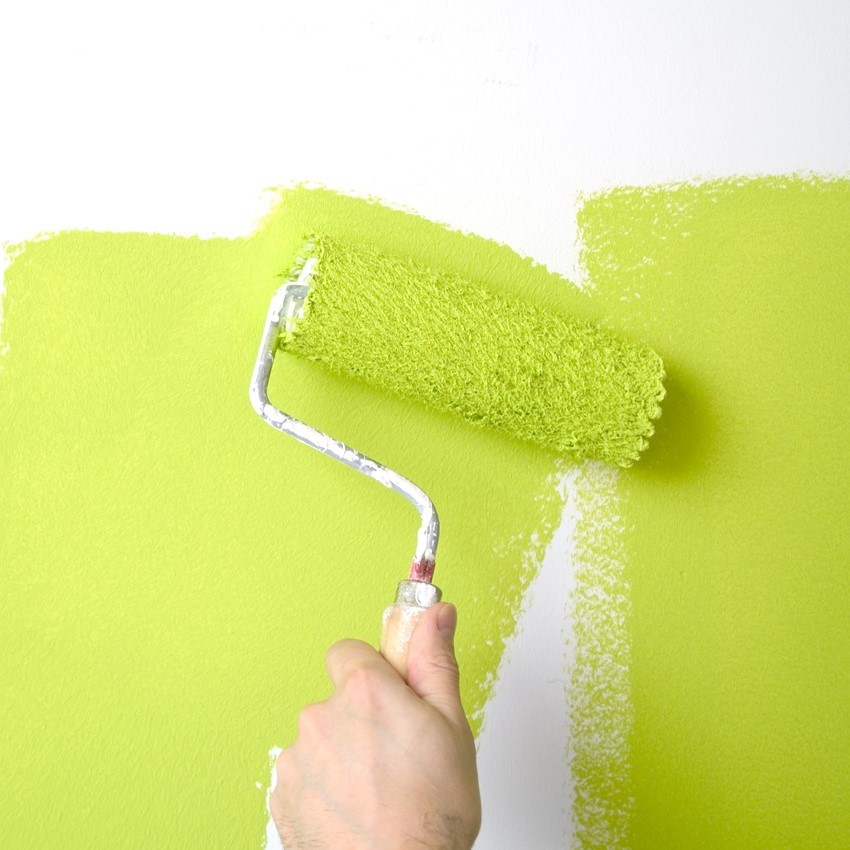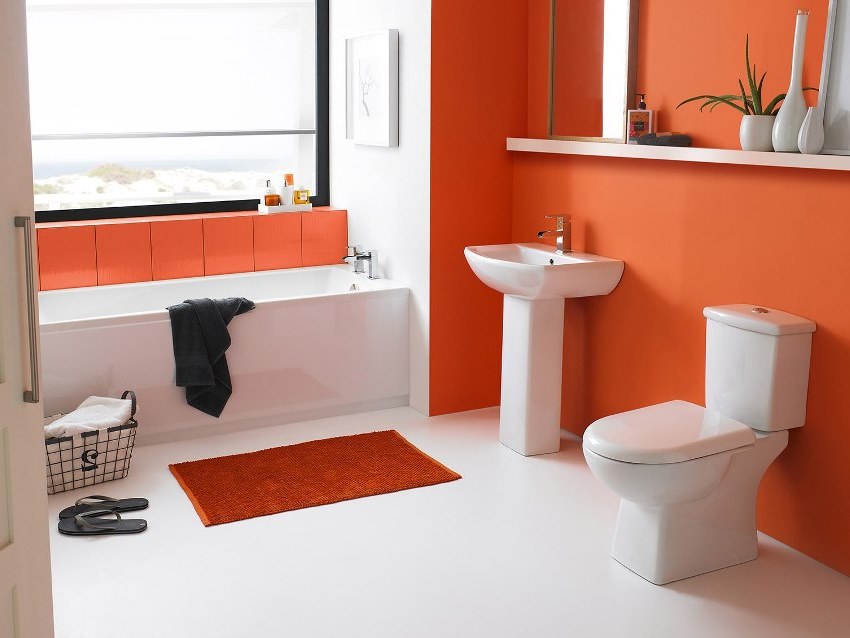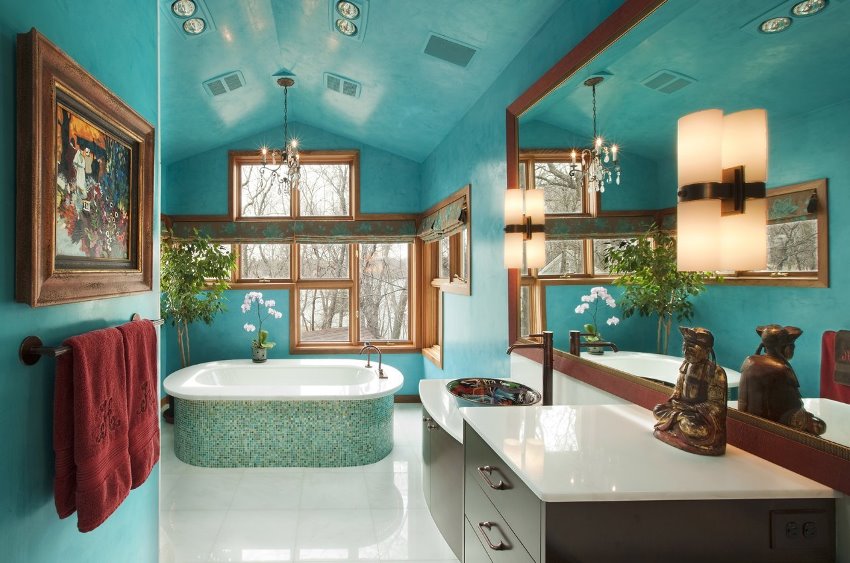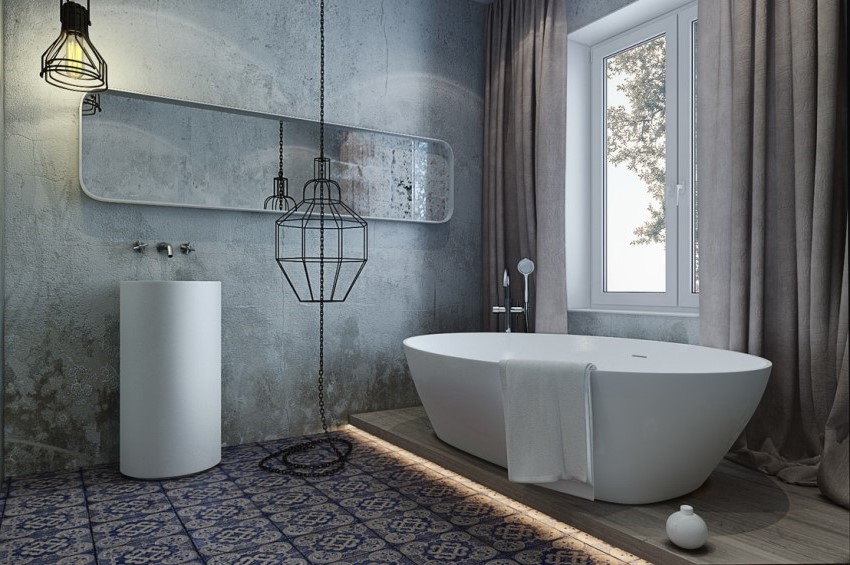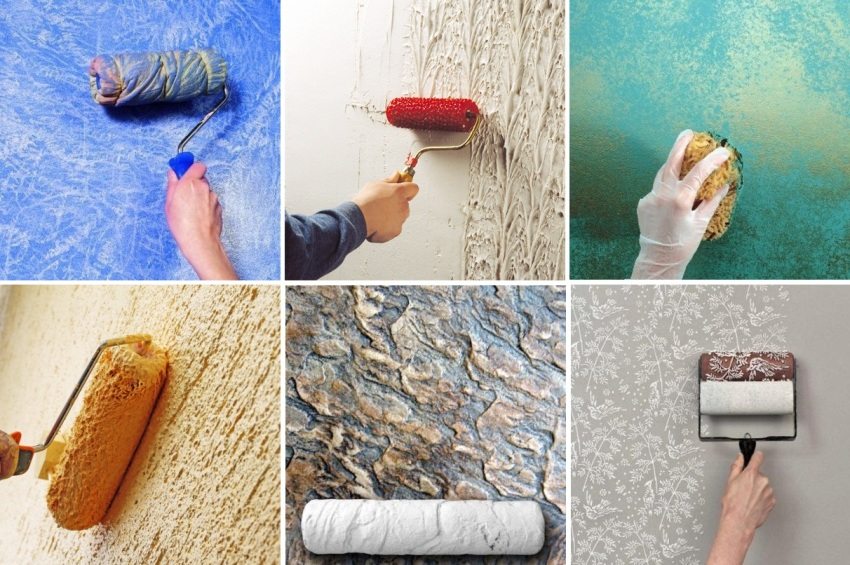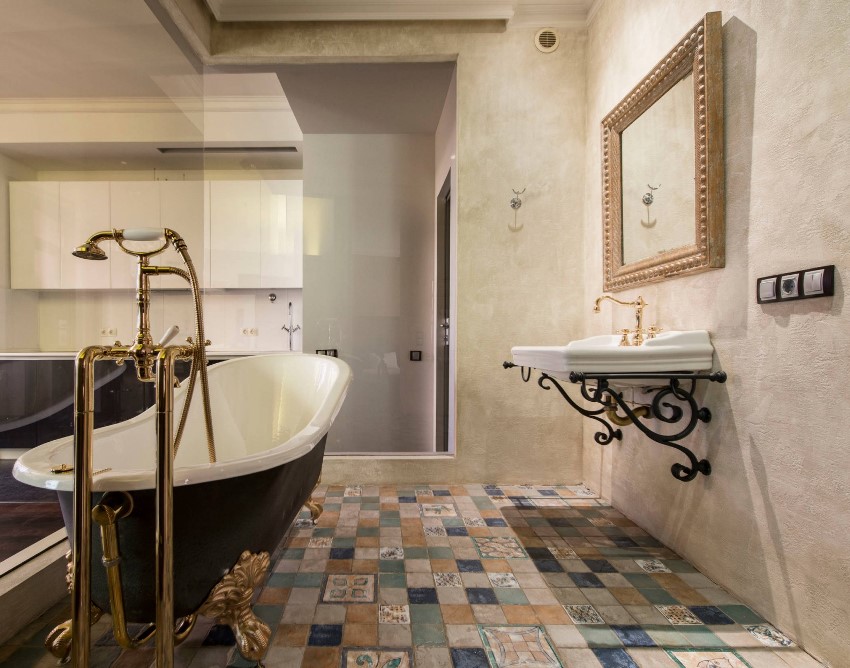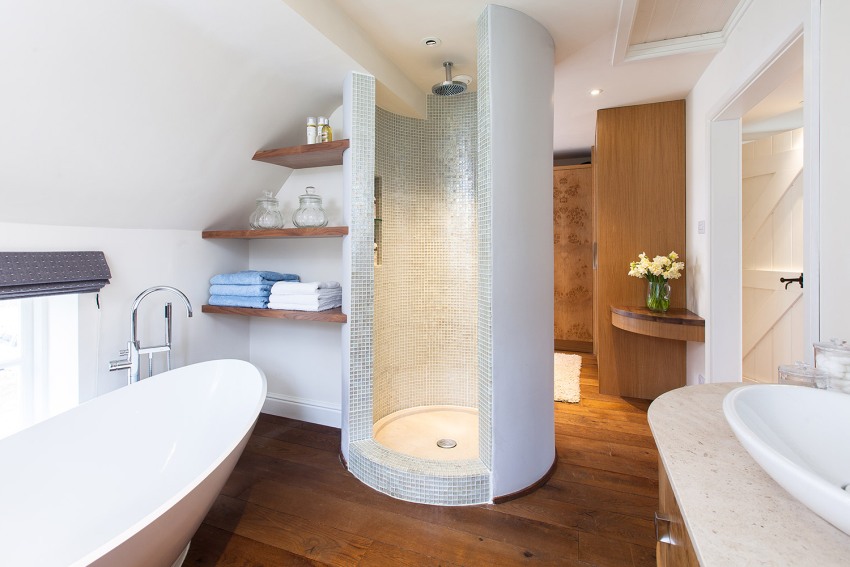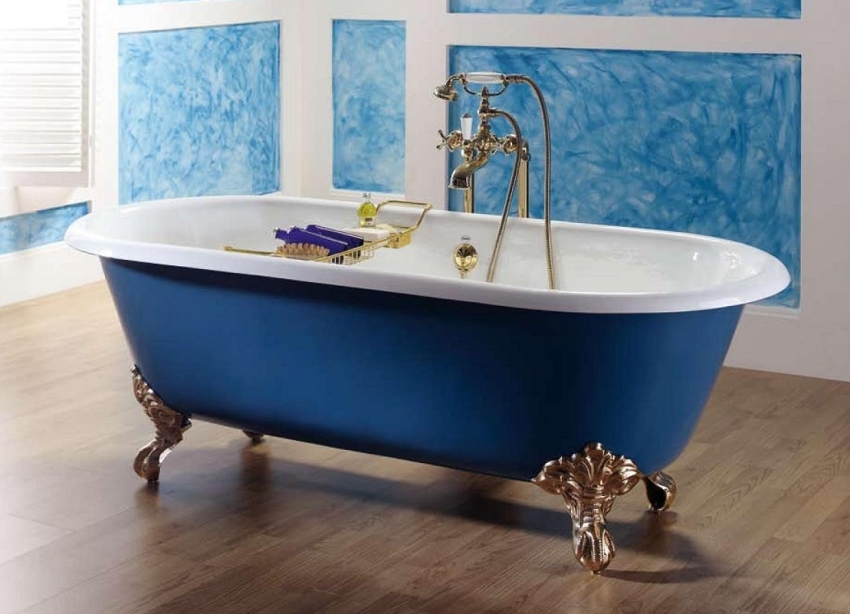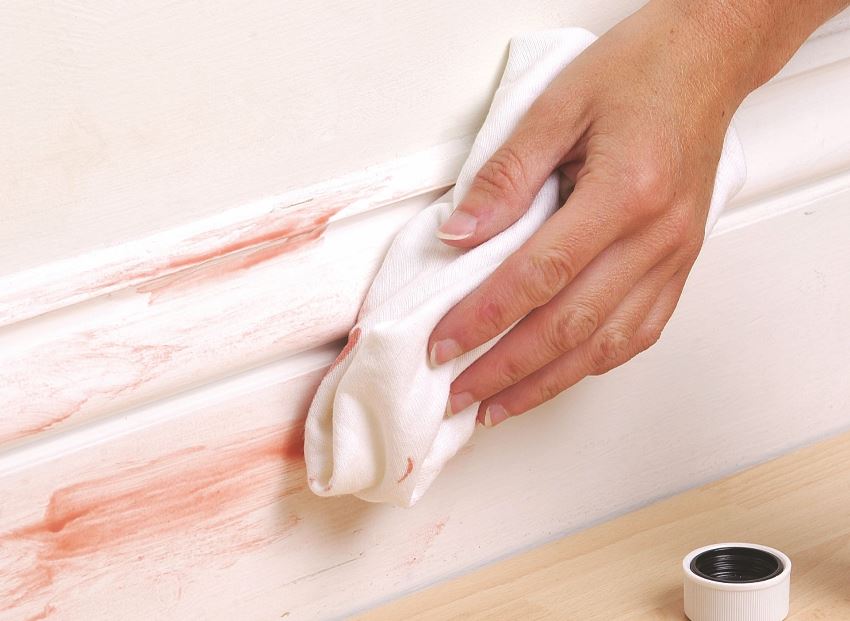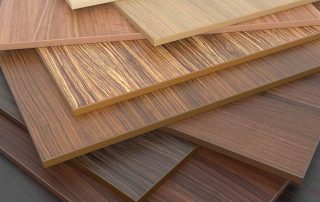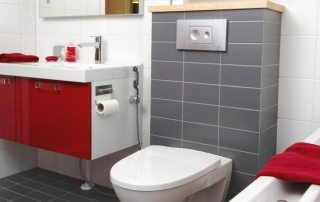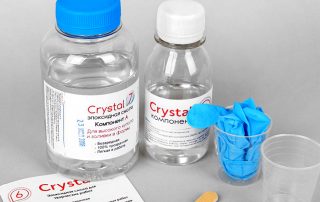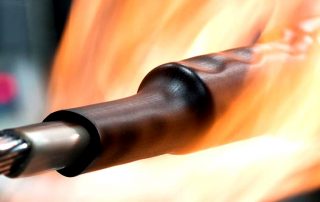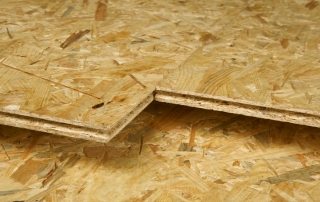From this article you can find out what features the paint for the bathroom has: a classification and an overview of the main types of compositions intended for rooms with high levels of humidity, their advantages and disadvantages. The text contains recommendations that will help determine the choice of a finishing material with optimal characteristics.
Content
- 1 How to paint the walls in the bathroom: choosing a finishing material
- 1.1 Are water-based paints suitable for bathroom walls
- 1.2 Latex-based bathroom paint: advantages and disadvantages
- 1.3 Advantageous Features of Acrylic Bathroom Paint
- 1.4 Pros and cons of using silicone wall paints in the bathroom
- 1.5 Characteristics of chlorinated rubber waterproof bathroom paint
- 1.6 Features of painting a bathroom with alkyd enamel
- 1.7 Features of the use of oil paints for walls
- 2 How to choose wall paint for an interesting bathroom
- 3 How to paint a bathtub with defects? Which formulations are best for this?
- 4 How to paint a bathroom: application technology and recommendations
How to paint the walls in the bathroom: choosing a finishing material
Bathroom renovation is an expensive and complex process that requires careful selection of materials. The room must be clean and moisture resistant. The presence of mold is unacceptable, therefore special requirements are put forward for wall decoration. The most affordable coating is the dye. This material is not only economical and easy to apply. Coloring compositions allow you to achieve unique interior solutions due to rich and rich colors that are obtained by adding pigments to the mixture.
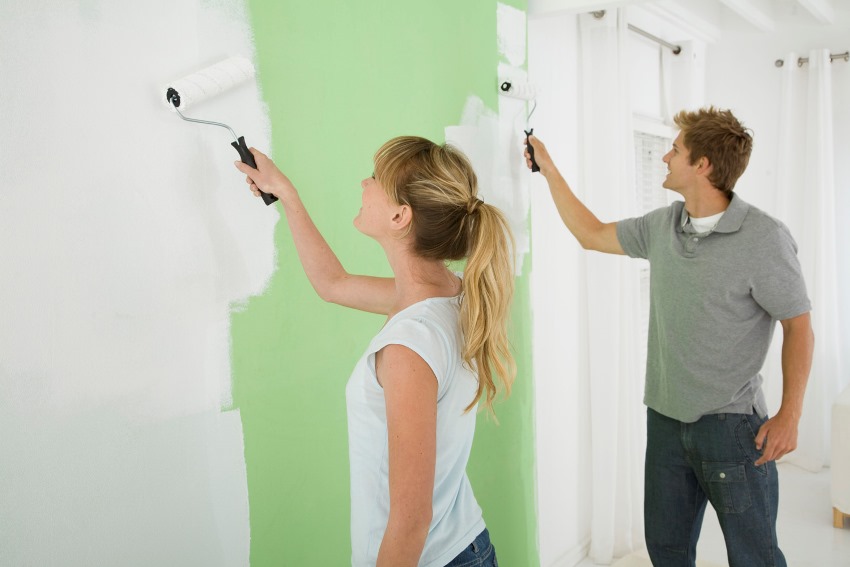
Coloring compositions for walls in the bathroom - the most affordable and popular type of finishing material
Note! Do not use the dye on areas that come into contact with water, such as around the sink and bathtub. It is desirable to finish these places with ceramic tiles or cover with glass panels.
To decide how to paint the walls in the bathroom, it is advisable to familiarize yourself with the existing range of compositions, weigh all the disadvantages and advantages of each of the types, and also determine which of the options is suitable for creating the necessary artistic effect.
The following types of wall paints are used as finishing materials:
- water emulsion;
- latex;
- acrylic;
- silicone;
- chlorinated rubber;
- alkyd;
- oil.
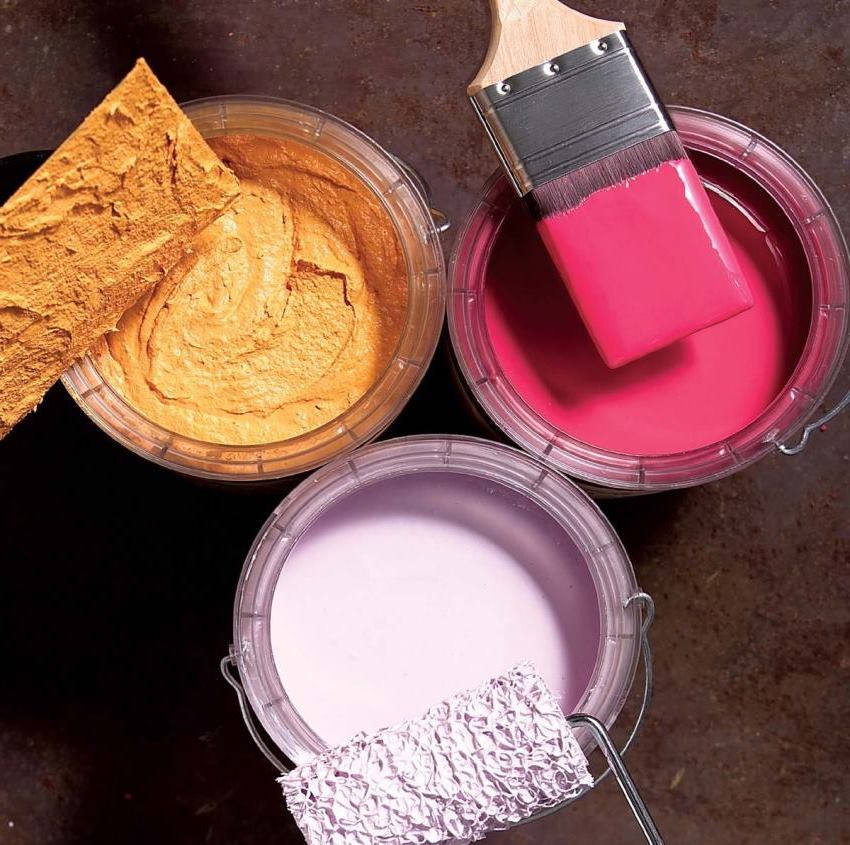
Before choosing a wall covering in a bathroom, it is worth studying the types of coloring compositions, their characteristics and properties
The most important properties of dyes used to decorate walls in a bathroom are water resistance and protection against microorganisms such as fungi and mold.
Are water-based paints suitable for bathroom walls
Water-based compositions are widely used for wall decoration. These dyes have a number of advantages:
- relatively low price;
- lack of unpleasant odor;
- simple application process;
- environmental friendliness and safety;
- the coating dries quickly;
- under the influence of sunlight, the surface retains its color well.
In the photo, painting the walls with decorative water-based compositions looks very attractive. Thanks to the optimal viscosity, a beautiful effect is obtained, therefore, designers have ample opportunities in choosing a wall covering. Using various tools, original designs can be applied to the surface. Water-based paints have an extensive color palette. By adding special pigments to the composition, you can get any shade that fits perfectly into the conceived bathroom interior design.
Water-based dyes are used to create matte and glossy surfaces. When choosing a material, it is very important to take into account the type of base, its structure, and also use a suitable primer. The advantage of these dyes is that any dirt can be easily removed from the surface by wiping the wall with a damp cloth or a sponge dipped in soapy water. After that, this area is re-painted.
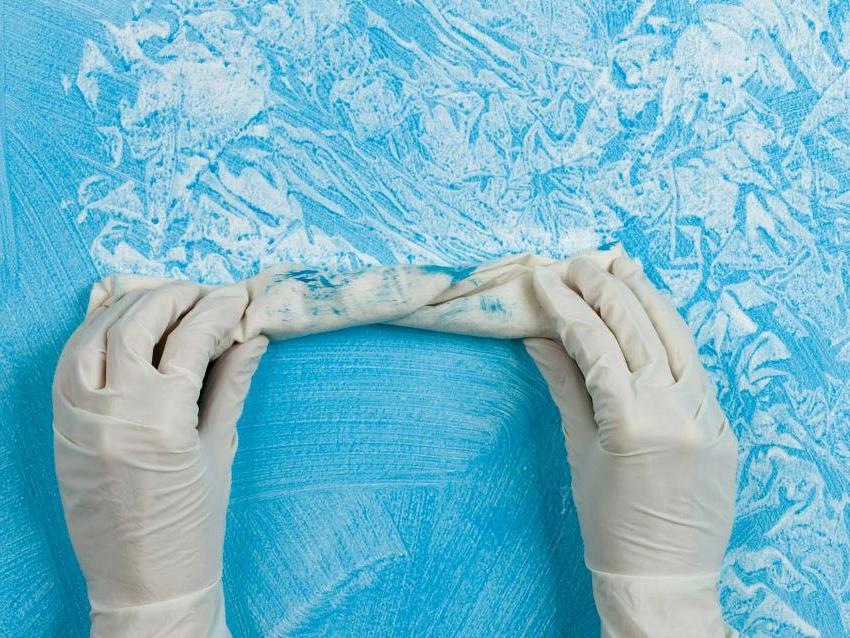
Using water-based formulations and special application techniques, you can get interesting decorative effects.
Important! It is not recommended to use water-based dyes in areas in contact with water. If this cannot be avoided, coatings with a glossy surface should be selected. They are more resistant to mechanical damage.
Latex-based bathroom paint: advantages and disadvantages
There are no antifungal additives in the latex dyes, therefore, before painting the walls in the bathroom, they must be treated with a special primer with antiseptic properties.
Benefits of latex-based dyes:
- an elastic surface that masks minor wall defects: cracks, chips;
- durable coating;
- resistance to mechanical stress;
- excellent decorative properties;
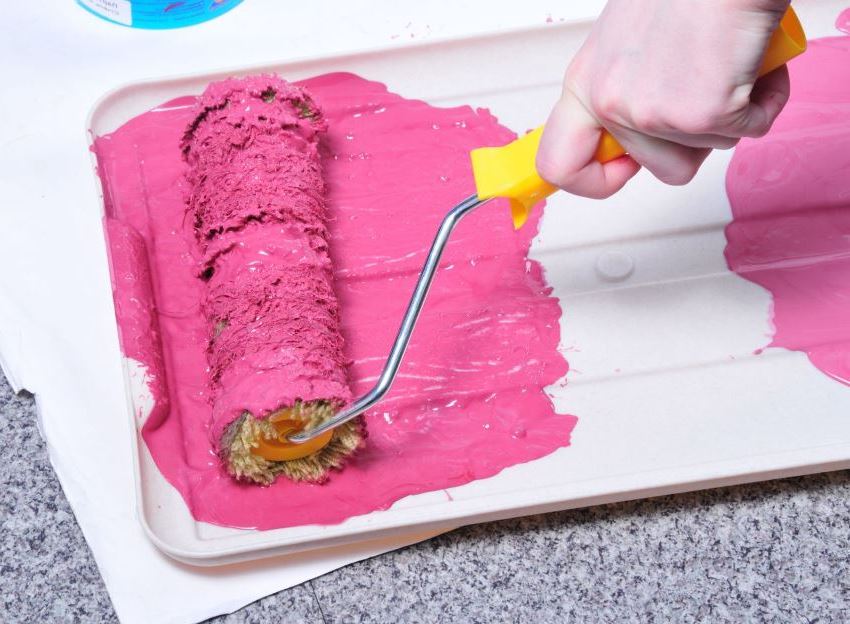
Coloring compositions based on latex are distinguished by a high level of resistance to mechanical stress
- lack of unpleasant odors;
- the dye creates a thin film on the surface that protects the walls from dirt;
- versatility;
- the maximum drying time is 2 hours.
The latex surface does not tolerate low temperatures quite well. As a result of their influence, the coating cracks. Latex dyes also react negatively to exposure to sunlight, which causes the coating surface to fade and lose brightness. The price of these compositions is much higher than that of water-based ones, so finishing work in the bathroom will be more expensive.
Advantageous Features of Acrylic Bathroom Paint
Experts consider acrylic compounds to be the best option for painting walls in a bathroom. This type of dyes belongs to water-dispersed finishing materials.
Why is it profitable to buy acrylic bathroom paint:
- large palette of colors and shades;
- resistance to dirt;
- simple application process;
- the presence of a light, but not pungent odor, which does not cause discomfort when painting the walls;
- dirt is easily removed from the surface;
- wiping the walls with a damp cloth and soapy water does not damage the coating;
- the dye contains antifungal additives that prevent the development of mold;
- compounds are positioned as waterproof bathroom paints, so they can be used to finish areas that are constantly in contact with moisture;
- no preparation of walls is required before painting;
- thanks to its optimal viscosity, the colorant hides small surface imperfections.
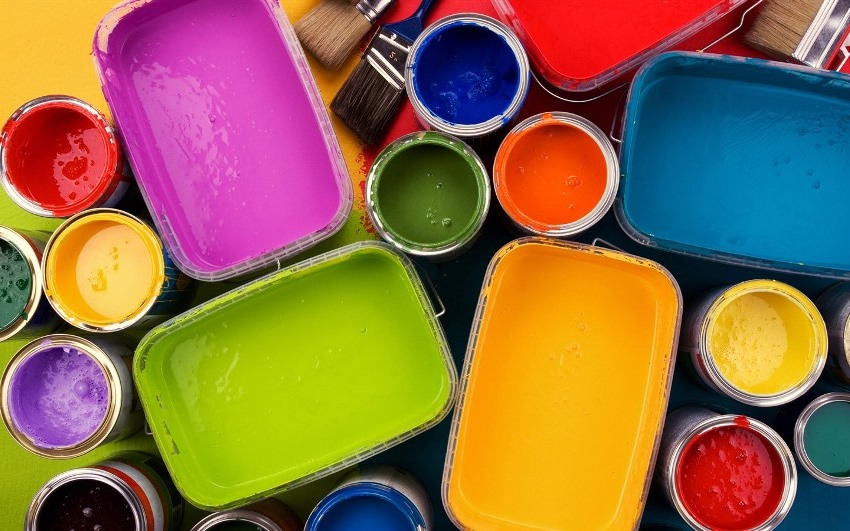
Due to its characteristics and properties, acrylic coloring compositions are considered the best option for painting walls in the bathroom.
Helpful advice! When choosing a dye, it is advisable to focus on the products of leading manufacturers. They are quite expensive, but they are able to create a high-quality and durable coating on the walls.
Pros and cons of using silicone wall paints in the bathroom
Thinking about what paint to paint the walls in the bathroom, you should pay attention to the compositions that have a silicone and silicate base. This category of finishing materials is very popular in the market due to its unique physical properties.
The advantages of silicone dyes:
- the coating is completely impervious to water;
- high resistance to dirt;
- the composition forms a coating with vapor-proof properties on the surface of the walls;
- the dye is able to cover significant wall errors, for example, potholes and deep cracks.
Silicone compounds belong to the category of waterproof bathroom paints. Water-based options are better than others, suitable for rooms with high humidity levels, but their cost is very high, which is the main disadvantage.
It is not recommended to use PVA-based silicone water-based paint for decorating walls in the bathroom. This composition is intended for rooms with a dry microclimate. It can only be used as a ceiling covering in a bathroom.
Characteristics of chlorinated rubber waterproof bathroom paint
The most reliable and practical coating option is chlorinated rubber paint. This compound can be an excellent substitute for mosaics or ceramic tiles. This type of coating does not need frequent updating and retains an attractive appearance for a long time.
Related article:
Bathroom and toilet repair, photos of interesting solutions
Various finishing methods. Materials most suitable for bathroom and toilet decoration.
Advantages of painting the walls in the bathroom with chlorinated rubber paint:
- moisture resistance;
- the coating is able to withstand constant contact with water;
- not afraid of direct exposure to sunlight;
- does not fade under the influence of ultraviolet radiation;
- subject to the correct choice of the composition, the dye can be used to decorate the walls in the bathroom;
- there are no harmful and toxic substances in the composition.
Careful preparation of the walls in the bathroom for painting with a chlorinated rubber compound is required. This type of coating is used on cement and metal surfaces. Moreover, this does not require preliminary application of putty and primer, but you will have to completely get rid of the old coating.
Wall decoration with chlorinated rubber paint can result in a significant amount. To obtain a high-quality finish, it is necessary to apply at least 3 coats to the surface. You will not be able to use common solvents. In this case, special formulations are used. However, the obtained result and favorable characteristics fully justify the costs of purchasing the material.
Note! Despite the absence of toxic and harmful substances in the composition, it is forbidden to use chlorinated rubber paint as a coating for containers where drinking water is poured.
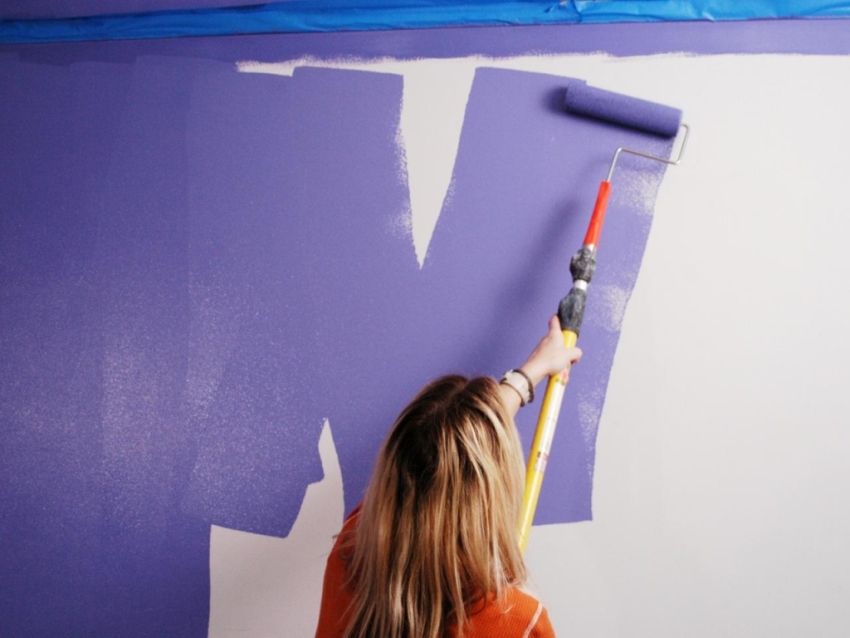
Having opted for a chlorinated rubber dye composition, it is worth remembering that you will need to apply at least 3 layers of coating to the wall
Features of painting a bathroom with alkyd enamel
All alkyd enamels are suitable for bathroom wall decoration. Due to the tension of the film, this coating perfectly repels water, so you can do wet cleaning of the walls without fear.
Why is it profitable to buy enamel for the bathroom:
- under the influence of sunlight, the color of the coating does not fade;
- excellent protection of metal against rust;
- durability of the coating;
- fast drying;
- the transparency of the layer well hides the errors on the walls.
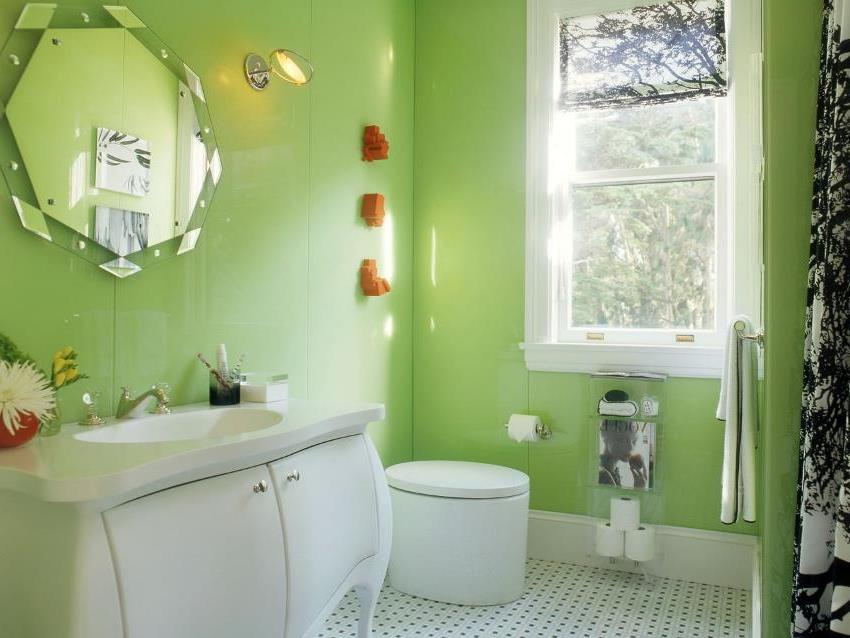
Dyes based on chlorinated rubber can cover the entire surface of the walls, including places that will come into contact with water
Alkyd enamels also have disadvantages. First, these formulations are characterized by an unpleasant and pungent odor. Secondly, the surface of the walls needs careful preparation before applying the dye. To prevent shattering, the base should be primed. A high-quality coating can be obtained only if several layers of alkyd enamel are applied.
Features of the use of oil paints for walls
Oil-based paints are considered the most affordable and budget finishing option. However, this category of materials has more disadvantages than advantages.
Cons of oil dyes:
- pungent odor during application;
- the coating dries for a very long time;
- paint is difficult to remove from the wall if renovation is required in the room.
Oil-based paint creates a vapor-impermeable film on the surface, which is a significant disadvantage, especially when it comes to the bathroom. In rooms with a high level of humidity, the walls must "breathe". Otherwise, perspiration will accumulate on their surface, which is a favorable breeding ground for bacteria.
The tightness of the oil film is useful for finishing bathroom floors. For walls, this type of dyes is completely unsuitable, since over time, the coating cracks and crumbles.
How to choose wall paint for an interesting bathroom
Having decided which paint is best for the bathroom walls, you should think about the colors of the future interior. The choice of shade depends not only on personal preference, but also on other factors:
- room style;
- room size;
- the amount of light;
- structural features of the room, for example, disadvantages or advantages that need to be hidden or emphasized.
Helpful advice! To achieve a harmonious combination when painting walls, it is advisable to take into account the colors of the plumbing.
Wall decoration with paint: photo finishing in the bathroom interior
If the bathroom is compact, then it is advisable to use light-colored coatings. Such a design will visually expand the space, and the use of pearl paint for the walls will enhance this effect. Pastel colors will ideally highlight bathroom furniture and fixtures, as these furnishings are often white. When opting for light colors, it is important to remember that this finish is applied to perfectly flat walls. Otherwise, all surface defects will be visible.
If there are minor flaws on the walls of the bathroom, it is better to use textured paints in light colors. To prevent the pastel design from looking monotonous, you can add contrasting colors to the interior.
Large rooms give a wider scope for painting the walls, the design in this case can be very diverse:
- combination of different types of finishes;
- play of contrasts;
- the use of patterns and drawings.
Wall painting options using geometric patterns, for example, triangles, rhombuses, zigzags, look interesting in the interior. Dark colors can be used to decorate the bathroom. However, it should be remembered that such surfaces show traces left by drops of water and soap. For this reason, it is advisable to cover those areas where moisture gets in with mosaics, glass panels or tiles.
How best to paint the walls in the bathroom: decoration in different styles
Dye is used as a wall decoration material in many styles. This material is suitable for classic style bathrooms. This design is not limited to certain textures and colors. In addition, the classic direction never loses its relevance.
The modern high-tech style is based on the use of strict glossy shades of cold colors. In this case, it is advisable to use different shades of blue and gray for wall decoration. Transparent, almost weightless shelves made of glass will be a great addition.
Styles such as art deco and pop art are based on unusual saturated colors. A bright green bathroom is perfect complementing cheerful pictures or drawings from comics.
The Provence-style bathrooms look original. The color scheme of this direction includes pastel shades:
- beige;
- pink;
- lilac, etc.
Helpful advice! To decorate a Provence style bathroom, it is better to use matte coatings decorated with floral ornaments.
Can I use decorative plaster for the bathroom
Decorative plaster can be used to decorate the walls in the bathroom, along with coloring compounds. These materials are perfectly combined with each other, creating effective combinations.
Most often, silicate moisture-resistant plaster for the bathroom is used as a finish. This type of material forms a durable coating on the wall. Its service life is over 50 years. Silicate-based plaster is completely impervious to moisture. Moreover, the coating does not interfere with the natural ventilation of the room. Silicate plaster is antiseptic and fireproof, so it can be used in rooms with high humidity levels.
Mineral plasters are also used to decorate bathrooms. The coating has a vapor permeability, due to which a comfortable microclimate is maintained in the room. The service life of this material is about 30 years.
Moisture-resistant properties are also inherent in acrylic plaster. It is flexible and easy to use. This type of coating will last at least 50 years.
How to paint a bathtub with defects? Which formulations are best for this?
Unlike plastic and steel products, a cast iron bathtub can last at least 50 years, while maintaining its characteristics. It is durable and excellent at keeping warm. But even with careful care, the enamel coating is not able to maintain its novelty throughout this period.
As a result of intensive use, various defects appear on the bath coating:
- yellowness caused by the deposition of iron contained in the water;
- chips that appear due to the use of aggressive detergents and temperature effects;
- cracks resulting from impacts and falling heavy objects.
Dyes are used to restore the whiteness and integrity of the cast iron bath coating. Of course, serious requirements are put forward for such compositions:
- water resistance and ability to withstand constant contact with liquid;
- resistance to the influence of low and high temperatures;
- resistance to aggressive detergents.
Two types of paints meet these requirements: epoxy and acrylic enamel.
Helpful advice! To renew the coating, experts advise buying acrylic paint for the bath, the price of such a restoration is 5 times less than the cost of a new bowl. Such savings can be achieved if the composition is applied by hand.
Restoration of the coating with epoxy paint for cast iron bath
Epoxy enamel is widely used for bathroom restoration. This product has already been tested and is perfect for coloring the bowl at home. Nevertheless, preparing the train for work requires complex manipulations. Therefore, not every consumer dares to buy an epoxy-based paint for a cast-iron bath.
The fact is that in addition to the base, the dye contains a hardener and a plasticizer. Dibutyl phthalate is used as a component providing plasticity. Thanks to him, the dye is thick and viscous. Without the appropriate experience and special tools, it is quite difficult to apply such a coating to the surface of the bath and obtain a uniform layer at the same time. Therefore, this kind of work is performed only by professionals.
Average prices for bath enamel with BASF dye:
| Package of services | Number of layers | price, rub. |
| Social | 2 | 2450 |
| Standard | 2 | 2700 |
| Reliable | 3 | 3500 |
Features of using acrylic paints for the bath, prices for restoration
Liquid acrylic has been recently used for bath restoration. Professionals claim that this dye has almost the same performance characteristics as epoxy enamel.
Acrylic is suitable for painting cast iron paint at home without the help of specialists. Although preparing a quality mixture requires some effort. Due to the high viscosity of the dye, it must be stirred for a very long time and thoroughly before application. Moreover, the mixture consists of a hardener and a base. No plasticizer is used in its preparation. This is what distinguishes acrylic paint from epoxy enamel.
The hardener has a liquid consistency, while the acrylic base is thick. A homogeneous substance is applied to the surface of the bath, so the mixture is stirred until it becomes fluid. In this case, the staining process itself is greatly simplified. Although, in comparison with epoxy enamel, restoration with acrylic paint is more expensive.
Average prices for bathroom restoration with liquid acrylic Stacril Ecolor:
| Package of services | Drying time, h | price, rub. |
| Stacril Ecolor | 36 | 2500 |
| Stacril Ecolor 2012 | 36 | 2750 |
| Stacril Ecolor 2015 profi | 16 | 3250 |
| Restoration with Finnacryl liquid acrylic | ||
| Finnacryl | 24 | 2850 |
| Finnacryl 2010 | 24 | 3400 |
| Finnacryl 2015 | 16 | 3900 |
| Finnacryl 2015 | 8 | 4550 |
Note! The rates indicated in the tables include a master's visit to the house, treatment of the bath, the cost of consumables, as well as the work of the craftsmen to apply acrylic or epoxy enamel to the surface of the bowl in one layer.
How to paint a bathroom: application technology and recommendations
When the design is thought out and materials for painting the walls are selected, you can get to work. At the initial stage, the surface of the walls should be prepared before applying the dye.
To do this, you need to remove the old coating:
- remove the tile;
- remove pieces of peeling plaster;
- wash away traces of obsolete alkyd or oil paint.
After that, the surface of the walls is carefully leveled and a finishing layer of putty is applied. It is desirable that it has a cement base.

Before painting, the walls must be completely cleaned of the previous coating, if necessary, level the walls and apply a finishing layer of putty
How to remove paint from a bathroom wall: ways to remove trim
At home, you can remove the dye from the walls in two ways: mechanical and chemical. The latter method involves the use of specialized washes. With their help, traces of the old coating can be successfully removed from metal and wood surfaces.
The effectiveness of washes on wall materials is not so high, therefore, most often craftsmen resort to mechanical processing. But they will be indispensable in those places where tool access is limited. In such cases, the required area is treated with a wash, which is applied to the surface with a brush. After a few minutes, the old coating will become gelatinous and can be easily removed with a spatula. If the wall is painted in several layers, the washing procedure is repeated several times.
Mechanical removal involves the use of a hand or power tool. If the old coating is badly damaged, you can limit yourself to using a cycle, an ax, a scraper designed for decorative coatings, a planer and other devices with a wide sharp edge.
If a primer has been applied to the wall prior to painting, hand tools cannot remove the coating. In this case, you need to use a power tool such as a drill, angle grinder, hammer drill, or blow dryer.
Note! To remove the old coating, a drill is used in combination with an attachment that has several metal chains. In the process, the links are frayed and can fly off. To avoid injury, it is imperative to check the condition of the chains and replace them promptly.
How to paint your bathroom walls correctly
A layer of primer is applied to the prepared wall surface. This composition must have antibacterial and waterproofing properties. Liquid chlorine bleach or copper sulfate can be added to enhance the antiseptic properties of the primer. It takes at least 12 hours to dry. After that, the walls can be painted in any color you like.
Depending on the manufacturer's recommendations, the dye is applied to the surface in 2-3 layers. First of all, you should process corners and hard-to-reach places. The wall is painted completely, only after that you can move on to the next one. For application, you can use a brush, paint roller, spray gun.
How to paint bathroom tiles: restoring old tiles
Renovation of wall finishes in a bathroom is expensive. If there is not enough money for a full repair, you can limit yourself to a cosmetic option.
The following types of bathroom tile paints are used to change colors:
- alkyd;
- acrylic;
- oil;
- latex.
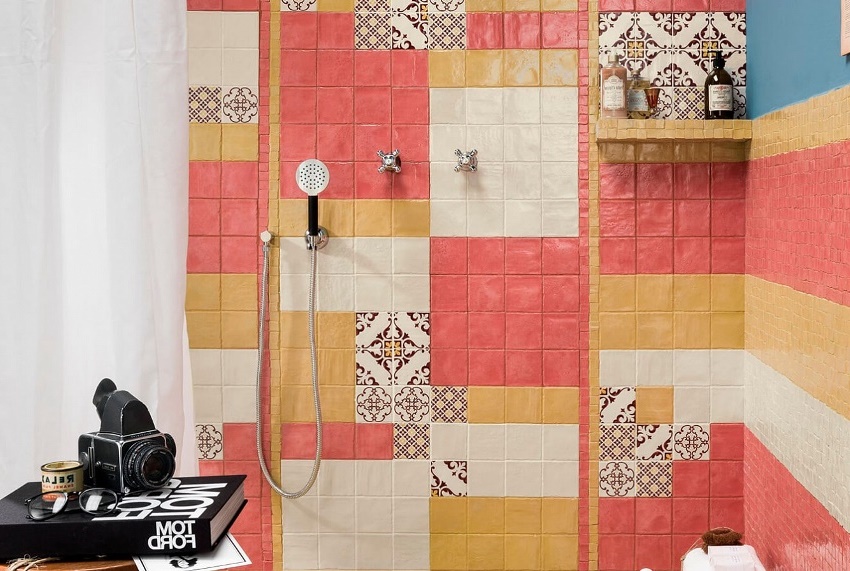
If for some reason it is not possible to replace the old tile - painting the tile will help to create a new bathroom design
These compounds fit perfectly on the surface of the tile, completely covering it. To ensure the required level of adhesion, it is necessary to sand the smooth and shiny surface of the tile. It is not recommended to dilute the dye in order to save money. A high-quality result is possible only if the consistency of the composition is dense. You can also find special dyes for ceramic and glass surfaces on the market.
Anyone can handle painting the walls in the bathroom. The main thing in this case is to use a high-quality dye that meets the requirements of rooms with a high level of humidity, as well as strictly follow the technology. During work, be sure to take into account the manufacturer's recommendations. Only in this case the coating will turn out to be strong and durable.
